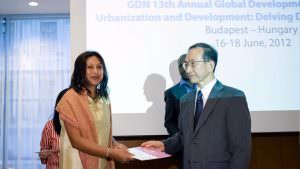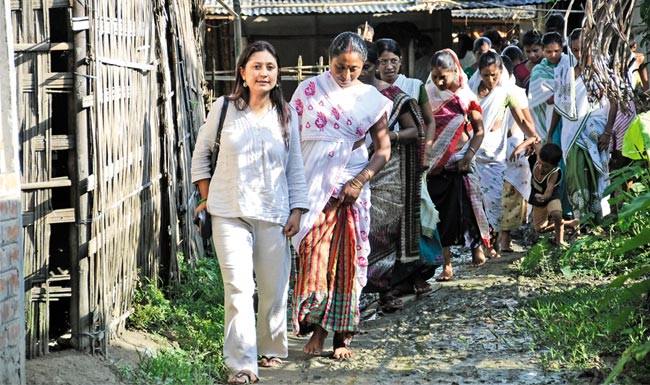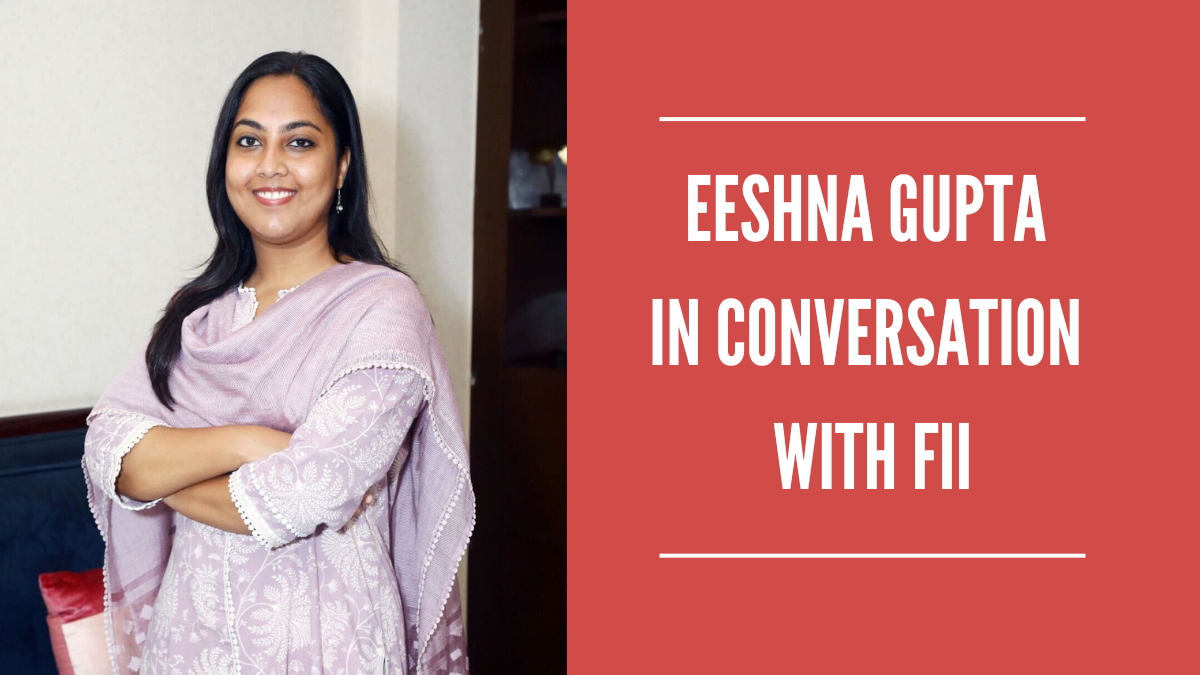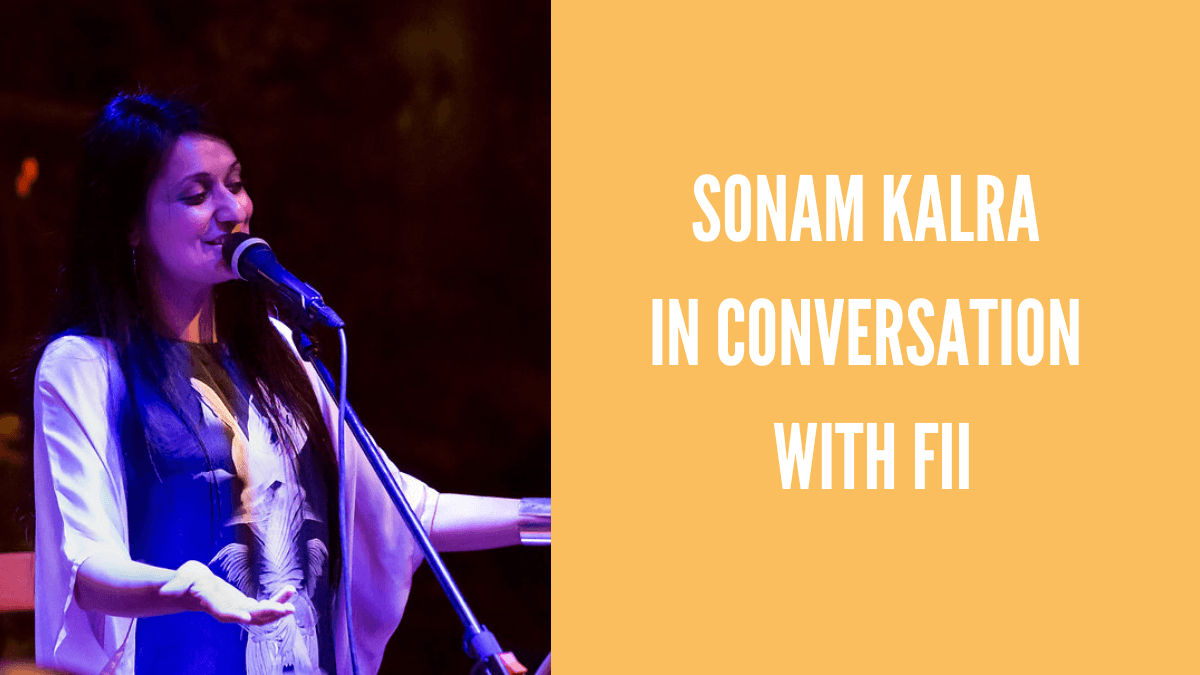Hasina Kharbhih is a nationally and internationally acclaimed human rights activist cum social entrepreneur. Her works on human trafficking are commendable. She was the person who came up with the Impulse Model for tracking human trafficking. She is the founder of Impulse NGO Network.
She has gained a multi-sector expertise, including leadership and institutional management, livelihood and rural development, anti-human trafficking, migration, gender based violence, child rights, HIV/AIDS education and intervention, substance abuse and adolescent health. Besides these, she is a trainer, a motivational speaker, a writer and a poet. She has many published books, and articles to her feat.
Feminism in India (FII) got a chance to interact with Hasina Kharbhih and profile her ground-breaking work.

Hasina Kharbhih in Budapest receiving the GDN Award
S.D.: What is a day in your life as a human rights activist and social entrepreneur in Meghalaya?
H.K.: I am a person who takes things positively no matter how difficult it is. In short, nothing is impossible and changes can happen. I am a workaholic, totally committed to my work and enjoy what I do. As a social entrepreneur, I am married to my vision and I cannot rest until I fulfil my vision. Challenges are part of life so the more the challenges there are the more I get inspired and strive hard to accomplish my goal.
S.D.: Please tell us how did your initiative Impulse NGO Network materialise?
H.K.: Impulse NGO Network’s journey began in 1993. Eventually it became an organisation established to combat human trafficking and acclaimed worldwide honour for its sterling work and success in countering human trafficking. During it’s initial days I along with other like-minded young people in Shillong, Meghalaya, North East India, started to work with livelihood initiatives and with rural artisans.
After spending a part of our life either rescuing women and children or rehabilitating them or raising money to support my work. At one point, it all seemed like a vicious cycle. I realised you cannot stop human trafficking unless women at the grassroots become economically self-sufficient.
Women in various parts of the Northeast are involved in small scale handicraft production – often in the backyard of their own homes. However the demand for such goods aren’t much at the local level. The income of these women artisans are minimal. But the scenario changes if these beautiful items, made of textile, silk and cane, are marketed properly on a national and global level. Thus, the idea of Impulse Social Enterprise was born.
Also Read: Six Women’s Movements From The North East That You Should Know Of
S.D: What made you think that a social enterprise would be a solution to protect women and children from unsafe migration and human trafficking?
H.K.: Social entrepreneurship has to have social outcomes. It is not about selling products or creating something new for the sake of creating something new. It’s not about ‘I made this and I’m doing it on my own.’ That might be entrepreneurship, but not social entrepreneurship.
Social entrepreneurship has a lot to do with human beings. Growth is not measured by the volume of profits, but in the change brought to the system or community values. That is something very important that anyone who decides to become a social entrepreneur needs to understand and define very clearly.
Trade, not aid, can change the lives of people– that’s my motto. I realised you cannot stop human trafficking unless women at the grassroots become economically self-sufficient.
S.D.: What is the Meghalaya Model? What challenges did you face while coming up with such a model?
H.K.: The Impulse Model earlier called Meghalaya Model is a model for tracking human trafficking. The Impulse Model has been replicated in all eight states of Northeast India. It has been piloted for national replication by the Government of India, and also adopted in Myanmar, Nepal and Bangladesh.
First there are the six Ps—partnership, prevention, protection, policing, press, and prosecution. Then there are the six Rs—report, rescue, rehabilitation, repatriation, reintegration and re-compensation. These six Ps and six Rs work very closely with one another to engage various stakeholders in addressing the issue, especially the law enforcement personnel who are needed to deal with human trafficking as a crime.
But beyond the crime, victims of human trafficking require various kinds of support systems. After reporting a rescue done by the police with the support of a social organisation, we have to go to the next process of rehabilitation. That’s where we brought in the department of Social Welfare to look into the resources that they can provide to a rescued victim.
But rehabilitation is short-term, next you have to repatriate. Most of the time, girls who are trafficked are brought to a destination point that is foreign to them. They have the right to go back to their own states or countries, and they need help reintegrating back into society and also re-compensation is done. That’s how the six Rs work and the whole model work.
The challenges I often face include enforcers not realising that trafficking is not prostitution, they would treat trafficking as any other crime. But addressing trafficking requires sensitivity.
The journey so far has been a roller-coaster ride. The day I stepped into this boat with the aim to promote and protect human rights, I knew that I was steering into something that requires perseverance and persistence. Over the years, I have faced threats and attacks from traffickers whom I have managed to put behind bars. Nonetheless, I strive to continue working because I strongly believe that these occurrences are a part and parcel in my line of work. Incidents like this provide inspiration because I know that I am capable of bringing about positive changes not only in the lives of the victims but also institutional and functional changes that are urgently required in the present scenario.
S.D.: How did you get various government agencies and stakeholders to work together to combat this problem?
H.K: The national research was like a road map presenting clear, factual data that India has a problem with human trafficking. Research is a very strong component of getting stakeholders to listen. The other component was tied to law enforcement training, which required participation at all levels of policing so that sensitivity towards the issue could be generated within the police departments. It can’t be something like, here—this is a problem and this is how you deal with it. You need a very participatory approach that engages people.
However, we realised that the capacity of a lot of law enforcement officers to understand and use the law effectively was not there. Most people working in law enforcement in developing countries are not highly educated. They are people who have been recruited into the forces not realising that there are these big problems they need to be part of addressing. We got the Northeast Police Academy to play a role in building a curriculum that reinforced the police department and trained the officers on a rigorous basis. We provided technical support. This engagement led them to accept that yes, their forces needed training and the training would lead to better crime protection.
It’s important to show different stakeholders that it’s in their best interest to be part of the anti-trafficking efforts. They all have a role to play in the constitutional and legal context of the country. We always bring the law into the discussion. It’s a very important starting point in the sense that we can approach different stakeholders and explain why they have an obligation to help. Then we give examples of how things can be done and work with them to develop a solution. That’s how the conversations move forward.
Also Read: Five Historical Women Leaders From North East India
S.D.: We know trafficking is a complex problem. How do you identify trafficking victims, given the layers of secrecy to hide victims from the law?
H.K.: When I started doing community work 25 years ago, I myself didn’t really understand what human trafficking was. My journey actually began with a mapping exercise that the team at Impulse NGO Network and I decided to do. From that exercise, we started to see that there was a human trafficking problem in our community because of all the rural to urban migration taking place. We began to ask ourselves: Why was this migration happening? Where was it happening? What was their destination point? Was there any tracking of the migrant process and how safe was it for them?
For identification of the trafficked victims we follow the Impulse Model where rescue operations are carried out by the respective Anti-Human Trafficking Units (AHTU), along with Impulse Case Info Centre (ICIC) or our state partner organisation. ICIC provides training to law enforcement agencies and partner organisations on all aspects of their responsibilities during the rescue operations, taking into consideration pre-rescue planning and post-rescue requirements as well as on victim-friendly and gender/child sensitive approach to conduct the rescue.
Even we identify trafficked victims through reporting about the victims too. Anyone can report a human trafficking case to ICIC, whether it’s a concerned family member or a stakeholder of the Impulse Model. A case can be referred to ICIC at any stage. The ICIC Case Manager assists in filing an First Information Report (FIR) at the police station, if it has not been filed. Once a case has been reported, ICIC documents the case in the ICIC database, and immediately refers the case to the respective AHTU and partner organisations at the source and destination points, both nationally and internationally. In the process, ICIC provides support to stakeholders in tracing the victim.
S.D.: We heard you also write poetry. How do you think poetry can be used for women’s rights and peace?
H.K.: Through poetry I trail the path of my unconscious mind, living the thoughts of mind which generally get lost in the day-to-day hectic life.
Also, I feel poetry is a form of expression and very often expression towards issues can be well described through poetry. Women’s rights issues can definitely take the help of poetry to describe it. I think poetry is a way to talk about which is very difficult. It helps to think about different issues of feminism. For me, poetry is a way of letting out issues. It is a great form of discussion and expression.
S.D: Tell us about your achievements.
H.K.: My journey as an Ashoka Fellow has been the most meaningful out of the many awards that I have received. It has actually brought me to understand the core value of my ideas. It has helped me scale my original idea from what it was in 2006 till now. The Ashoka recognition also came at a point when nobody was really trying to understand my ideas at all. But Ashoka understood the innovation I was creating very closely.
I think that as a social entrepreneur, Ashoka’s guidance gives me the ability to make the innovation a reality today. I think it’s very natural for a lot of social entrepreneurs to be always looking for solutions, and if solutions are not there readily, we will go beyond what’s apparent to see a how solution can be developed. If there is a problem there has to be a solution.
Impulse Model has led to Impulse NGO Network receiving accolades such as the Japanese Award For Most Innovative Development Project under its category for Global Development Awards and Medals Competition in 2012 from the Japanese Social Development Fund for the Government of Japan which has also supported the organisation to scale its work in Myanmar since 2013.

Hasina Kharbhih plans to take Impulse NGO Network on a global platform
S.D.: What is the next project/thing you’re working on? Where do you see Impulse in the next five years?
H.K.: My goal going forward is long-term prevention of activities to address human trafficking by providing livelihood initiatives through Impulse Social Enterprises. It’s a social mission driven company comprising various brands, products, and services that uplift communities and advance the mission for equitable human rights.
I believe that not only the elderly men and women are eligible to take active steps in forming or reshaping the society but young minds are equally efficient and capable of taking steps in making a change, this insight made me innovate what the Impulse Model is. Well, I see the Impulse NGO Network as a global organisation, which goes beyond South-East Asia.
Featured Image Credit: outlookbusiness.com
About the author(s)
Presently pursuing MA in Women's Studies and trying to explore the field of 'Gender and Media'. Strongly interested in writing since childhood.




